Gigabyte Z68X-UD3H-B3 Review
by Brendan van Varik on July 11, 2011 7:01 AM EST- Posted in
- Gigabyte
- Motherboards
- Sandy Bridge
- Z68
LAN Speed Test
LAN Speed Test is a freeware program designed for testing the network connection between two PCs on a home network. The speed of the transfer is limited by the lowest common denominator on the network, so if you have gigabit Ethernet capable computers but a 100 Mbit capable router, you are limit to 100 Mbit transfer. Note that this is really a formality – if a network port is rated at 1 Gbps, then chances are that it will hit at least 90+% of this value. The main test here is CPU usage, and how much is offloaded by the controller. For this test, we use LAN Speed Test to transfer a 1000 MB file across a home network with a 100 Mbps lowest common speed to the same machine each time, in a read/write scenario. CPU usage is taken as a visual max/average from task manager.
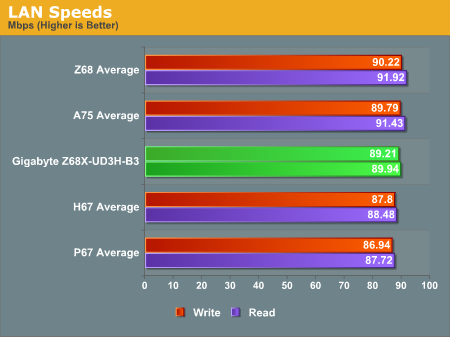
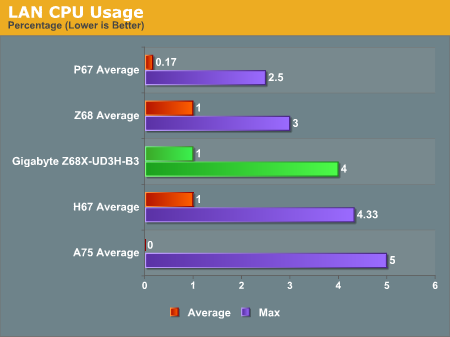
Good to see the Realtek controller doing its job properly here - the board is certainly a very strong contestant in the networking department.
DPC Latency
Deferred Procedure Call latency is a way in which Windows handles interrupt servicing. In order to wait for a processor to acknowledge the request, the system will queue all interrupt requests by priority. Critical interrupts will be handled as soon as possible, whereas lesser priority requests, such as audio, will be further down the line. So if the audio device requires data, it will have to wait until the request is processed before the buffer is filled. If the device drivers of higher priority components in a system are poorly implemented, this can cause delays in request scheduling and process time, resulting in an empty audio buffer – this leads to characteristic audible pauses, pops and clicks. Having a bigger buffer and correctly implemented system drivers obviously helps in this regard. The DPC latency checker measures how much time is processing DPCs from driver invocation – the lower the value will result in better audio transfer at smaller buffer sizes. Results are measured in microseconds and taken as the peak latency while cycling through a series of short HD videos - under 500 microseconds usually gets the green light, but the lower the better.

The Gigabyte performs very well - 120us is lower than almost all the other motherboards.
USB Speed
For this benchmark, we run CrystalDiskMark to determine the ideal sequential read and write speeds for the USB port using our 64GB Patriot SuperSpeed USB 3.0 drive. Then we transfer a set size of files from the SSD to the USB drive, and monitor the time taken to transfer. The files transferred are a 1.52 GB set of 2867 files across 320 folders – 95% of these files are small typical website files, and the rest (90% of the size) are the videos used in the Sorenson Squeeze test.
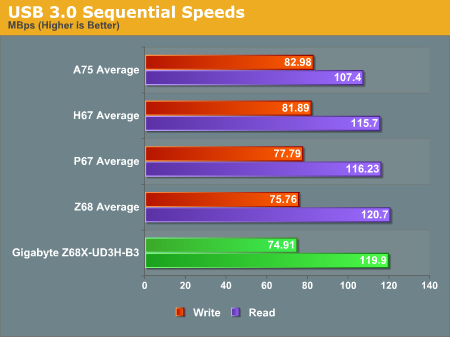
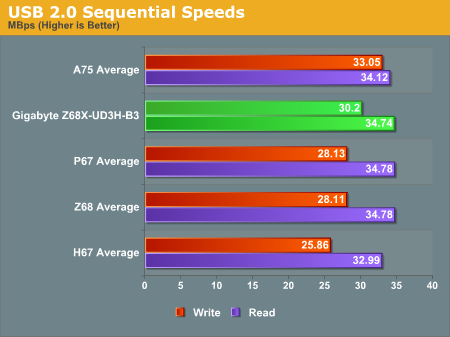
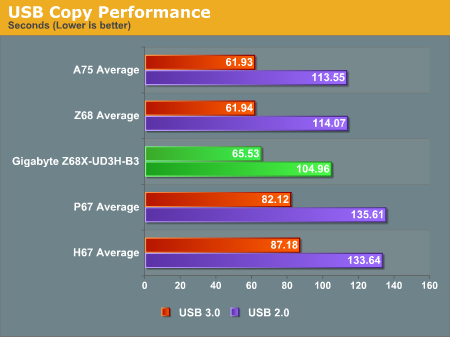
The USB2.0 speeds are more or less all the same. However, this board really shines when it comes to the write speeds. It’s on average 5MB/s faster than most of our boards we’ve tested and is only really contested by ASRocks’ XFast technology. The copy time is fairly average. On the USB3.0 side of things, the results are not anything spectacular.
SATA Testing
We also use CrystalDiskMark for SATA port testing. The operating system is installed on the SSD, and the sequential test is run at the 5 x 1000 MB level. This test probes the efficiency of the data delivery system between the chipset and the drive, or in the case of additional SATA ports provided by a third party controller, the efficiency between the controller, the chipset and the drive.
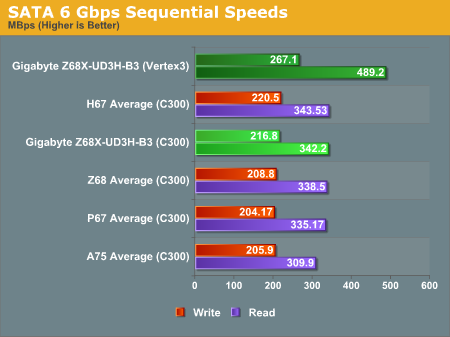
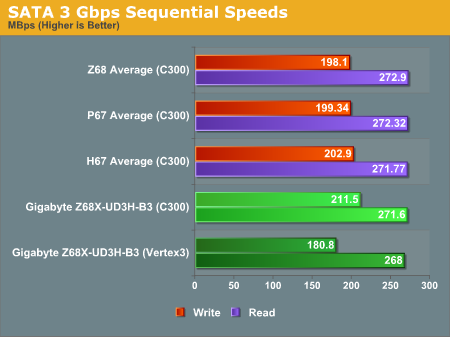










70 Comments
View All Comments
Taft12 - Monday, July 11, 2011 - link
Though your specific case leads a problem, I still think there are more PCI cards in use in the world's PC's than PCIe x1 cards. Also, why did you get a 3-slot GPU when you had 3 other expansion cards you wanted to use??Gigabyte DOES do the right thing by placing an x1 slot ABOVE the highest x16 slot. This should be standard practice on all motherboards and sadly it is not.
cyberguyz - Tuesday, July 12, 2011 - link
The point I was trying to make is that PCI cards are on the way out. They are obsolete. In order to implement them on the latest chipsets, the motherboard manufacturer actually has to include extra components to bridge the PCI slots to PCIe. Yes, there are still people using PCI cards - I agree, but that number is decreasing every year in favor of PCIe cards.As to why I am using a video card that uses 3 slots... I wanted a video card with very high performance that runs nice and cool. Simple. Very high performance video cards that run cool use coolers that take up 3 slots.
Yes, having that one slot above the PCIe x16 slot helps - as long as the PCIe card is small like a cheap network controller or 2-port SATA software raid controller. Some mobo makers put a BIG northbtridge heatsink just inboard of that 1x slot which blocks all but the shortest cards. I would not advise putting a Creative Labs Fatility Titanium pro soundcard there though. The metal shield gets awful close to the backside of the video card (granted would be a problem with any PC with loaded slots) and blocks airflow (video cards need airflow on the backside as well as the cooler side).
There are some motherboards that do away with the PCI slots altogether, but they suppliment the PCIe slots with a secondary PCIe controller/bridge (i.e. Maximus IV Extreme-Z), but you are going to pay dearly for that.
enterco - Monday, July 18, 2011 - link
@On-topic: I don't see any reference to the limitations of the Intel RST when used with RAID configurations. If anyone succeeds to enable SSD caching/acceleration of an array with two existing volumes, please let me know. I know that Intel RST 10.5 , combined with mixed configurations, such a 2 drives array with one striped volume and with a secondary mirrored volume aren't too popular, but this kind of configuration can't be accelerated with Z68's SSD caching combined with iRST ver. 10.5.@Cyberguyz: I see that you are trying to suggest toat PCI devices are obsolete.
Let me share some of my experience.
Chapter one: I've used a PCIe sound card: SB X-Fi Titanium Fatal1ty Pro until one of the SMDs burnt. After that event, the sound card wasn't able to use the analogic inputs/outputs and the driver provided by the vendor no longer installed properly. I believe that the burnt SMD was responsible with the power delivery to the analogue I/O part of the sound card.
Chapter two: I tought that 'using PCI Express' will 'bring me to today', so I bought an Asus Xonar D2X instead of an Asus Xonar D2/PM. I'think i've made a bad decision, and I'll explain why. The D2X has two things different from the D2/PM: it includes a PCI Express-to-PCI bridge [a supplemental component], and it needs to be powered by a molex/floppy connector.
So... why would anyone want to add latency to the audio system and take care of the extra power cable ? It may be useful ONLY IF the PCI variant, D2/PM can't fit into the computer.
When I bought my Asus sound card, I wanted something 'new', not the obsolete PCI version, but today I would choose the PCI version if I must buy a new sound card.
Chapter three. Recently, I was looking for a PCI Express USB3 controller. I wasn't able to find one without: a) a molex/floppy power connector; b) PCI Express X4 connector. I'm trying to show that the power provided by a PCI Express X1 is not always enough for some devices.
I think that the PCI slots are mature and powerful enough, even for today's standards, to be taken into consideration. A PCI Express X1 slot provides less power than a PCI slot, which may imply the need for an additional power connector to the card.
On the Intel 486 / Pentium days there was a sound card, the AWE32 and AWE64. None of them were PCI-based, even if PCI was mature at the time. The bandwidth provided by the ISA slots was enough for these cards.
Let's do some math. A sound card using 4 channels , 16 bit/sample at 44,1 kHz sampling rate requires approx. 3,4 Mbit/sec bandwidth. Multiplying the number of channels, the sampling rate and the bits per sample, to today's standards, a sound card does not need more than 70 Mbps bandwidth. A PCI bus, 33 bit, 33 MHz, can provide 1 Gbps bandwidth, meaning that a sound card at today's standards can use only 1/16 of the bandwidth of the PCI/32bit/33MHz bus.
just4U - Tuesday, July 12, 2011 - link
For me finding a PCle Sound card (locally) is a real pain. Atleast one I'd actually buy. PCI variants are around in abundance so there's still a call for it.DanNeely - Tuesday, July 12, 2011 - link
There's no single layout that will suit all GPU layouts; so it behooves you to pick a board with a good layout for what you want. With 3 slot GPUs being much rarer than 2 slot SLI configurations you can expect to remain on the short end of the stick for the number of suitable layouts.As for legacy PCI remaining on boards I don't expect to see it go away on full size ATX boards any time soon. With only 8 1x lanes available on the southbridge there isn't enough connectivity available to fill out all 5 slots and attach all the misc devices. Firewire, audio, non intel SATA, non intel nic (x2?), USB3 port pair (x2? x3?) all eat away at the SBs limited connectivity. If thunderbolt starts showing up in future systems it'll only make the connectivity situation worse.
A 1 PCIe to 4 PCI bridge chip brings the situation back to roughly what it was in the prior generation; FW, and audio fire easily on PCI . It's not quite as good as it was on last generation chipsets though since you only have 11 connections vs 13 (8 + 5); I suspect this may be behind the drop in the number of boards with an x4 slot. While they could use a 1:4 PCIe bridge instead, older PCI parts are probably cheaper and they don't want to lose out on sales to the minority with at least one PCI device they still need. Exposing those ports to end users could have issues as well since they could bottleneck at much lower system load levels than DMI would.
Unless Intel bumps the SB PCIe lane count to 12 (or goes PCIe 3.0 on the SB), goes all up SATA 3.0, and adds at least a half dozen USB3 ports (if not all up) to the next generation chipset I expect we'll see legacy PCI lanes on most of next years crop of boards as well.
PR3ACH3R - Monday, July 18, 2011 - link
What (could have been )an amusing comment,if it wasnt for the fact that no one on his right mind would put a GTX 570 on any machine he cares about a High end Pcie sound card.
not to mention total disregard of the simple (& obvious) fact that most professionals/users if theyr'e at all using an expensive pro card, 80% of it is PCI.
But hey you have a point, they should have consulted you, not the market analysts.
poohbear - Monday, July 11, 2011 - link
totally blows about the bios' lack of graphical layout. The asus boards are so convenient for having the newer bios' and i feel like im in 2011. These old bios' screens belong to the 90's that everyone still uses..:pMr Perfect - Monday, July 11, 2011 - link
I would agree. I'd pass up this board on that fact alone. Everyone else has their act together when it comes to a UEFI interface, what the major malfunction here? Not acceptable from a tier one board manufacturer.Taft12 - Monday, July 11, 2011 - link
I dunno guys, if you can't handle a keyboard-only interface, you should hand in your geek-cred cards now. This is Anandtech after all!cyberguyz - Tuesday, July 12, 2011 - link
Y'know - the UEFI in those others do have an advanced mode that does all the same things as the old char mode bios. I kinda like the bootup UEFI and really don't want to dual-boot Windows on my Linux box just to fart around with a graphical bios (and yes, I have been working with character mode bios as long as character mode bios have existed - my earliest adventures with overclocking was with jumper caps on a 486 board ;D ).But to each their own.